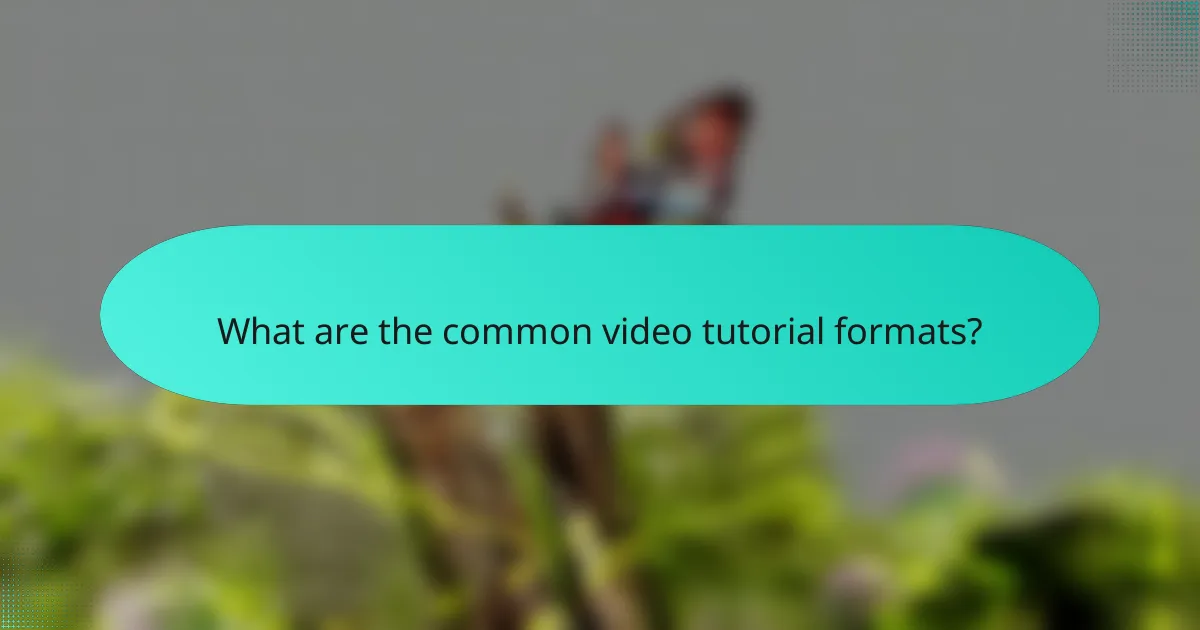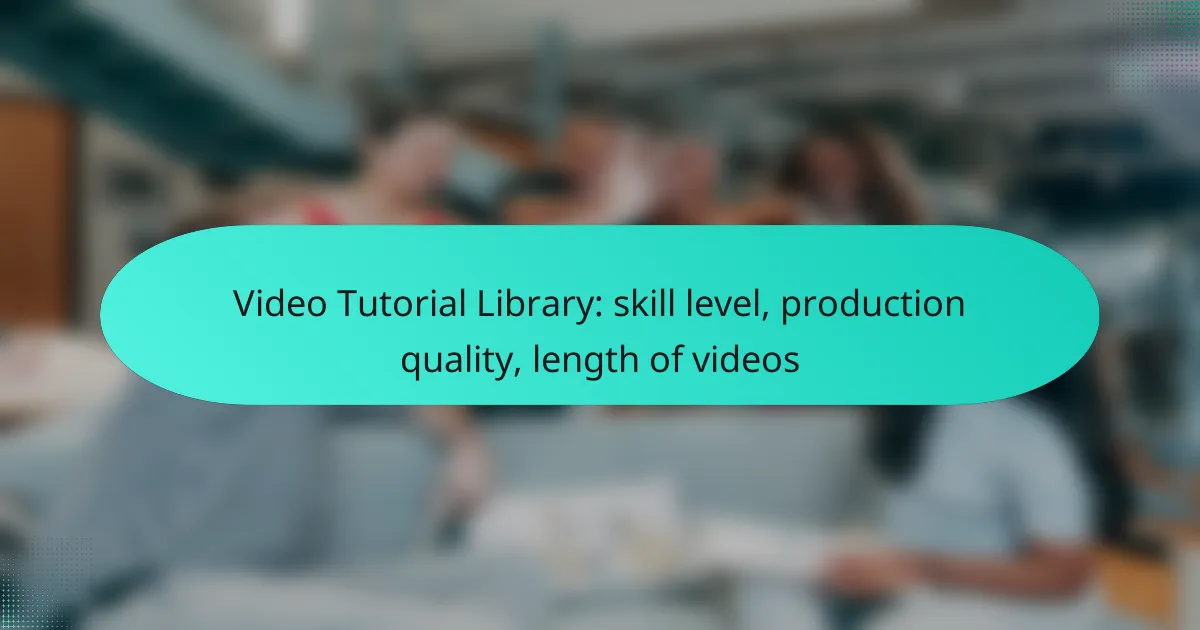The best video tutorial platforms in the UK provide a diverse range of skill levels, production quality, and video lengths to suit various learning styles. Whether you’re a beginner seeking foundational knowledge or an advanced learner looking to refine your skills, these platforms offer tailored content to meet your needs. High production quality enhances the learning experience, ensuring that visuals and audio are clear and engaging.

What are the best video tutorial platforms in the UK?
The best video tutorial platforms in the UK offer a variety of skill levels, production qualities, and video lengths to cater to different learning preferences. Popular options include Udemy, Skillshare, LinkedIn Learning, Coursera, and MasterClass, each with unique features that appeal to various audiences.
Udemy
Udemy is known for its extensive library of courses across numerous subjects, catering to beginners and advanced learners alike. Courses vary widely in production quality, with many created by independent instructors, which can lead to inconsistent experiences.
Video lengths on Udemy typically range from a few minutes to several hours, allowing learners to choose based on their available time. When selecting a course, check user reviews and ratings to ensure quality and relevance to your goals.
Skillshare
Skillshare focuses on creative skills and practical topics, making it ideal for those looking to enhance their artistic or entrepreneurial abilities. The platform emphasizes community interaction, with projects and feedback from peers being integral to the learning process.
Most Skillshare videos are concise, often between 10 to 30 minutes, which suits learners who prefer bite-sized content. Consider participating in community discussions to maximize your learning experience and gain insights from others.
LinkedIn Learning
LinkedIn Learning offers a professional approach to online education, with courses designed to enhance workplace skills and career development. The platform features high-quality video production and a structured learning path, which is beneficial for serious learners.
Videos typically last from 2 to 15 minutes, making it easy to fit learning into a busy schedule. A subscription model provides access to a vast library, allowing users to explore various topics without additional costs per course.
Coursera
Coursera partners with universities and organizations to provide courses that often mirror traditional academic programs. This platform is suitable for learners seeking in-depth knowledge and credentials from recognized institutions.
Courses can range from a few weeks to several months, with video lectures often lasting between 5 to 20 minutes. Be aware that some courses may require a fee for certification, so consider your budget when enrolling.
MasterClass
MasterClass features courses taught by renowned experts in various fields, such as cooking, writing, and filmmaking. The production quality is exceptionally high, providing a visually engaging learning experience.
Videos are generally around 10 to 30 minutes long, making them accessible for learners with limited time. While the subscription fee is higher than other platforms, the unique insights from industry leaders can justify the investment for many users.

How to choose video tutorials based on skill level?
Choosing video tutorials based on skill level involves assessing your current knowledge and selecting content that matches your learning needs. Beginners should look for foundational tutorials, while those with more experience can seek intermediate or advanced resources to deepen their skills.
Beginner-friendly tutorials
Beginner-friendly tutorials are designed for individuals with little to no prior knowledge of the subject. These tutorials often cover basic concepts, terminology, and fundamental techniques, providing a solid foundation for further learning.
When selecting beginner tutorials, look for videos that are around 10 to 30 minutes long, as they typically focus on specific topics without overwhelming the viewer. Ensure that the tutorials include clear explanations and visual aids to enhance understanding.
Intermediate skill tutorials
Intermediate skill tutorials cater to learners who have a basic understanding and are ready to tackle more complex topics. These tutorials often build on foundational knowledge and introduce new techniques, tools, or concepts that require prior experience.
For intermediate learners, videos ranging from 20 to 60 minutes can be effective, as they allow for a deeper exploration of subjects. Look for tutorials that challenge your skills while still being accessible, and consider those that include practical examples or projects to apply what you’ve learned.
Advanced skill tutorials
Advanced skill tutorials are intended for experienced individuals looking to refine their expertise or explore specialized areas. These tutorials often assume a strong grasp of the basics and delve into intricate techniques or advanced theories.
Advanced tutorials can vary significantly in length, often exceeding 60 minutes, as they cover comprehensive topics in detail. When choosing these resources, prioritize those that offer in-depth analysis, expert insights, and opportunities for hands-on practice to further enhance your skills.

What is the importance of production quality in video tutorials?
Production quality is crucial in video tutorials as it directly impacts viewer engagement and comprehension. High-quality visuals and sound help learners absorb information more effectively and maintain their attention throughout the lesson.
High-definition video
High-definition (HD) video enhances the clarity of visuals, making it easier for viewers to see details. A resolution of at least 720p is recommended, with 1080p or higher being ideal for intricate subjects. This level of quality ensures that text, diagrams, and demonstrations are sharp and legible.
When producing HD content, consider the capabilities of your audience’s devices. Most modern smartphones and computers support HD playback, but always check your target demographic to ensure compatibility.
Clear audio quality
Clear audio quality is essential for effective communication in video tutorials. Poor sound can lead to misunderstandings and frustration, causing viewers to disengage. Using a good microphone and minimizing background noise can significantly improve audio clarity.
For best results, aim for a sound level that is consistent and free from echoes or distortions. Recording in a quiet environment and using soundproofing techniques can enhance the listening experience, making it easier for learners to follow along.
Professional editing
Professional editing is vital for creating polished video tutorials that flow smoothly and keep viewers engaged. Effective editing can eliminate unnecessary pauses, enhance pacing, and add visual aids or annotations that reinforce key points. This level of refinement helps maintain viewer interest and improves overall comprehension.
When editing, consider using transitions and effects sparingly to avoid distractions. Aim for a clean, straightforward presentation that highlights the tutorial’s content without overwhelming the viewer with excessive visuals or sounds.

How does video length affect learning?
Video length significantly impacts learning by influencing attention span and content retention. Shorter videos tend to facilitate quick understanding, while longer videos allow for deeper exploration of complex topics.
Short videos for quick learning
Short videos, typically ranging from a few minutes to about ten minutes, are ideal for quick learning sessions. They cater to users with limited time and help maintain focus, making it easier to absorb key concepts without overwhelming details.
These brief tutorials are particularly effective for introducing new skills or concepts. For instance, a quick five-minute video on a specific software feature can provide immediate, actionable insights without requiring a significant time commitment.
Longer videos for in-depth understanding
Longer videos, often exceeding ten minutes, are suited for comprehensive learning experiences. They allow for detailed explanations, examples, and context, which are crucial for mastering complex subjects.
When engaging with longer content, learners can expect to dive deeper into topics, such as a 30-minute tutorial on advanced programming techniques. This format is beneficial for those looking to develop a thorough understanding and apply their knowledge effectively.

What are the common video tutorial formats?
Common video tutorial formats include live sessions, pre-recorded tutorials, and interactive video content. Each format has unique characteristics that cater to different learning preferences and objectives.
Live sessions
Live sessions involve real-time instruction, allowing learners to interact with the instructor and ask questions on the spot. This format is beneficial for topics that require immediate feedback or clarification.
Typically, live sessions can last anywhere from 30 minutes to a few hours, depending on the subject matter. They often utilize platforms like Zoom or Microsoft Teams, which facilitate engagement through chat features and polls.
However, a key consideration is scheduling; participants must be available at the same time, which can limit accessibility for some learners.
Pre-recorded tutorials
Pre-recorded tutorials are videos that have been created and edited before being shared with learners. This format allows for polished content and the ability to cover complex topics without time constraints.
These tutorials can range from a few minutes to several hours, depending on the depth of the subject. They are often hosted on platforms like YouTube or specialized learning management systems, making them accessible at any time.
One advantage of pre-recorded tutorials is that learners can pause and rewatch sections, enhancing understanding. However, they lack the immediate interaction found in live sessions.
Interactive video content
Interactive video content combines traditional video with elements that engage the viewer actively, such as quizzes, clickable links, or branching scenarios. This format promotes deeper learning by requiring participation from the viewer.
Typically, interactive videos can last from a few minutes to about an hour, depending on the complexity of the interactions. They are often used in e-learning platforms to enhance user engagement and retention.
While interactive content can be more engaging, it requires careful design to ensure that the interactions are meaningful and contribute to the learning objectives. Avoid overly complex interactions that may confuse learners.
